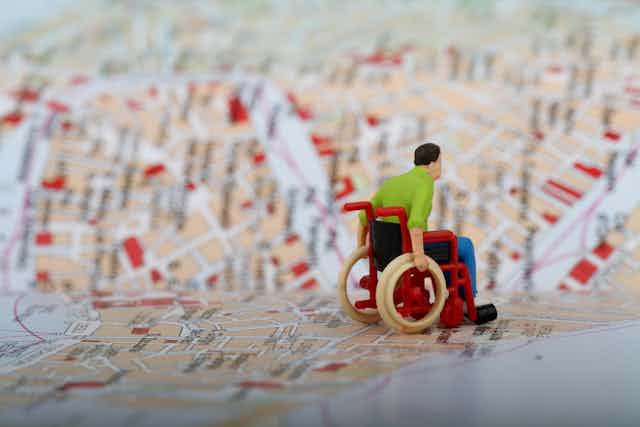In September 2016, 4,350 Paralympic athletes will arrive in Rio de Janeiro to compete for medals across 23 different sports. The games in Rio have a lot to live up to. London’s 2012 Paralympics proved to be a magnet for sponsorship, and competitors have said that the crowds – and their enthusiasm – were unparalleled. But there’s another respect in which the 2012 games set the standard for future Paralympic tournaments: it made the host city itself more accessible.
In order to secure their bid for the London 2012 Olympic and Paralympic games, organisers had to make two key promises to do with transport. One was to make public transport a key part of their sustainability agenda. The other was to make London 2012 more accessible than any previous games. London 2012 was planned as a public transport-driven games, and the London Organising Committee of the Olympic and Paralympic Games (LOCOG) took action to maximise its usage.
The challenges
To live up to their promises, the committee had to overcome a number of challenges. Parts of London’s transport system had to undergo a radical overhaul. The commitments also had major implications for venue design, equipment and even the workforce of the games. And because the idea of “legacy” was central to all of the preparations for the games, the solutions put in place needed to work over the long term – not just the main event.
When LOCOG started its work, disabled people’s confidence in using the public transport network was very low, so there was a need to change people’s perceptions through advertising. The demand from disabled people to attend the Paralympics was higher than expected, but organisers did not know what sort of mix of disabled spectators they needed to plan for. For example, while they knew that many groups of wheelchair users would be arriving, they did not know how many would be using electric wheelchairs, manual wheelchairs or scooters – each of which has different requirements for travel.
Finally, the transport system needed to be flexible enough to accommodate the extra short-term influx and diverse needs of disabled people, and revert back to more “standard” operations after the event. For a transport system first developed in the mid-1800s, these were no small demands.

The London Underground – commonly known as “the tube” – was the first underground rail network in the world. At some points, the tracks are almost 60m below ground. Modernising such a system involves working around complex arrangements of existing infrastructure. For example, adding a two-lift shaft to Green Park station in central London in time for the games required engineers to build a straight path between pedestrian tunnels, escalators, stairwells and the platforms themselves – not to mention finding the least disruptive times to carry out the developments and space to store the construction equipment.
Such logistics meant that it was impossible for LOCOG to create new accessible entrances into all of the stations. Nevertheless, the organising committee worked with Transport for London, the city’s transport authority, to adapt the public transport system and improve accessibility.
The changes
Evidence such as wheelchair ticket sales, pre-booked journeys and increased lift usage suggests that many more people with disabilities were using public transport throughout the games. Tactile paving and protective walls at the platform edges made the system safer for the visually impaired. And 66 of London’s 270 functioning tube stations were fitted with step-free access, while the overground DLR system was fully accessible.

In many stations – particularly on the Piccadilly line – the issue was the height difference or the gap between the platform and the carriage floor. Changing the position of the platforms would have been disruptive and costly. So instead, platform ramps were installed across four stops on the Piccadilly line, while manual ramps were provided at 16 strategic stations, to make it easier for wheelchair users to get on and off the train.
These ramps not only benefited disabled people but could be used by the wider community, including parents with pushchairs and tourists with suitcases. They were left in place after the games as part of LOCOG’s legacy commitment. And since then, they have been added to 28 more stations.
Of course, there’s still much to be done before London can be a truly accessible city – a fact highlighted by Paralympian Hannah Cockroft, who challenged London Mayor Boris Johnson to spend a day navigating the tube in a wheelchair (he declined). And there are concerns that the momentum toward further improvements is waning.
But London 2012 still marked a major leap forward in disabled access to public transport. Through a combination of controlled traffic management, communication with Londoners and collaboration with industry partners, LOCOG was able to develop practical and efficient transport solutions. These did more than fulfil the transport requirements for the Olympic and Paralympic Games: they also left a legacy value for Londoners to enjoy, and set a new standard in games-time transport.
Now, Rio is taking the challenge to heart, by launching projects to improve accessibility in the city ahead of the 2016 Olympic and Paralympic Games. Indeed, British experts have been actively involved in helping to transfer the learning from London 2012 to improve accessibility for Rio 2016. Rio has a golden opportunity to seize this legacy opportunity and set even better standards. Let the games begin.
This article is part of a series on the outlook for Rio 2016. You can also find out why your city won’t want to host the next Olympics, and discover the story of the favela fighting back against Olympic developments.

